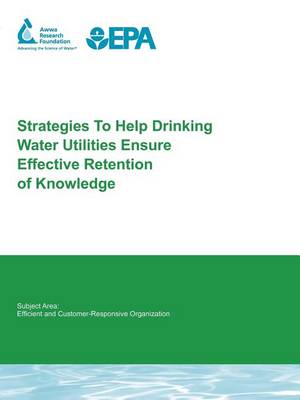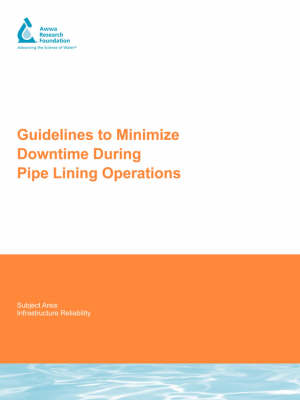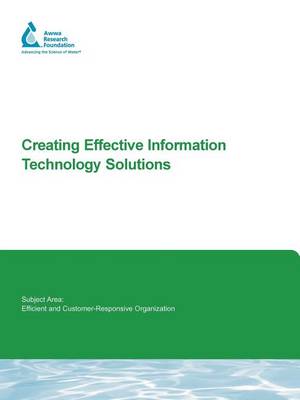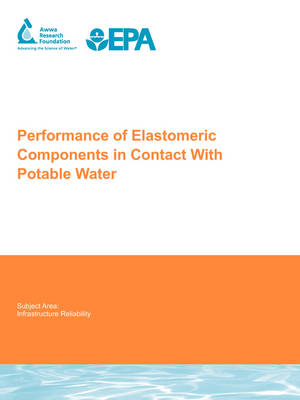Water Research Foundation Report
5 total works
Strategies to Help Drinking Water Utilities Ensure Effective Retention of Knowledge
by Linda Blankenship, Terrance M Brueck, and M. Rettie
Published 31 January 2009
Knowledge retention is a significant issue for water utilities, as employees are retiring or leaving to seek other opportunities. This phenomenon is not unique to water utilities, so there is an opportunity to adapt approaches that have proven successful in other industries. Utilities that successfully deal with knowledge retention will be much better equipped to deal with the challenges ahead-increasingly stringent regulations, higher customer expectations, aging infrastructure needs, technology pressures, economic constraints, and more.
The objectives of this project were to (1) define a methodology for how utilities can implement knowledge retention based on an understanding of the key drivers, critical success factors, barriers, costs, and benefits; and (2) develop specific strategies, tools, and techniques that can be used immediately by utilities. Secondary research was reviewed to identify knowledge management best practices and key trends especially relevant to drinking water utility experience. An online survey provided initial data on drivers, barriers, costs, and benefits for drinking water utilities, supplemented with stakeholder interviews. An experiential workshop provided additional input into drivers, barriers, and benefits of knowledge retention, and identified knowledge retention strategies and tools to be validated. An interim report was prepared to expedite the transfer of findings. Incorporating Retirees, Mentoring, Document Repository, Organizational Learning and Training (OLT), and Social Network Analysis (SNA) were selected for piloting and using desktop and field approaches. A second workshop was conducted to gather the pilot results from using these tools and further refine the strategy and business case.
The objectives of this project were to (1) define a methodology for how utilities can implement knowledge retention based on an understanding of the key drivers, critical success factors, barriers, costs, and benefits; and (2) develop specific strategies, tools, and techniques that can be used immediately by utilities. Secondary research was reviewed to identify knowledge management best practices and key trends especially relevant to drinking water utility experience. An online survey provided initial data on drivers, barriers, costs, and benefits for drinking water utilities, supplemented with stakeholder interviews. An experiential workshop provided additional input into drivers, barriers, and benefits of knowledge retention, and identified knowledge retention strategies and tools to be validated. An interim report was prepared to expedite the transfer of findings. Incorporating Retirees, Mentoring, Document Repository, Organizational Learning and Training (OLT), and Social Network Analysis (SNA) were selected for piloting and using desktop and field approaches. A second workshop was conducted to gather the pilot results from using these tools and further refine the strategy and business case.
Guidelines to Minimize Downtime During Pipe Lining Operations
by Thomas D. Rockaway, R. Timothy Ball, Terrance M Brueck, Penny Brink, and Theo van den Hoven
Published 12 September 2007
When repair and rehabilitation of existing infrastructure is necessary, many utilities employ techniques that reuse the existing conduit to reduce the impact to customers, existing surface facilities, and traffic flow. Pipe renewal operations are generally less expensive and less disruptive than open trench replacement; however, customers must still endure service disruptions and general construction environments. While infrastructure improvements ultimately benefit customers in the long-term, utilities benefit when they reduce short-term customer dissatisfaction. Repair and maintenance of existing distribution lines is an increasing concern for utilities. While pipe lining activities are effective and generally less expensive than complete replacement, they still represent considerable time and expense.
The purpose of this research was to provide guidance on the best practices to minimize the downtime associated with pipe lining operations. In this context, "downtime" refers to the amount of time customers are without water service, must endure restricted service, or are served by less secure networks. Minimizing the amount of downtime and improving temporary service will have a direct impact on customer satisfaction and costs. The data collection from the selected utilities during this project suggested that a number of best management practices have the potential to reduce the length of time necessary for pipe lining operations and consequently, the length of time a temporary pipeline is in service. Each recommended management practice would require a shift or change in what is currently considered a typical construction practice. The construction processes recommended have the potential to significantly reduce the number of days or weeks most customers are subjected to maintenance activities and the temporary pipeline.
The purpose of this research was to provide guidance on the best practices to minimize the downtime associated with pipe lining operations. In this context, "downtime" refers to the amount of time customers are without water service, must endure restricted service, or are served by less secure networks. Minimizing the amount of downtime and improving temporary service will have a direct impact on customer satisfaction and costs. The data collection from the selected utilities during this project suggested that a number of best management practices have the potential to reduce the length of time necessary for pipe lining operations and consequently, the length of time a temporary pipeline is in service. Each recommended management practice would require a shift or change in what is currently considered a typical construction practice. The construction processes recommended have the potential to significantly reduce the number of days or weeks most customers are subjected to maintenance activities and the temporary pipeline.
Creating Effective Information Technology Solutions
by Terrance M Brueck, Bruce Mcclung, M. Rettie, and R. Lackmann
Published 31 August 2004
Technology offers one of the significant levers that utility managers have available to truly “do more with less.” But it often is difficult for managers to know how much to spend on technology, where the expenditures should be, and what the expected return on that investment should be.The objective of this study was to determine successful approaches for implementing utility IT systems considering the range of factors influencing today’s utility IT environment. The study cites leading practices that create effective IT solutions (not technology-specific solutions). While specific technology evolves quickly, what does endure are the management and business practices around how technology is selected, implemented, used, and managed. Those practices are process-oriented, repeatable, and measurable and are the focus of this project.A benchmarking consortium of 13 leading North American utilities and three research organizations was formed to initiate the research project, drawing on utilities that included leading practitioners in many IT areas, all of whom wanted to improve their IT effectiveness. The following steps summarize the overall project approach:Plan: Secondary research identified IT practice elements and grouped them into focus areas that significantly contribute to the effectiveness and value of IT services. Collect data: For each focus area, specific practice elements and metrics were developed to identify leading practices using a survey instrument. Analyze data: Completed surveys from the consortium were analyzed to identify case study candidates. Benchmarking partners were identified via the same survey to complement areas for other best practices. Report effective practices: Detailed survey information, analyses, and conclusions were documented from the case studies. The survey results of the case studies were compared to the other participating utilities. A number of observations and possible implications were drawn from the findings. In general, the average scores of the case studies were notably higher than the average scores of the participating utilities, indicating that the case study organizations do derive greater results from their technology investments. Some other key differences were noted between the case studies and other respondents. In general, the case study organizations:have a higher total annual revenue per customer for all services provided; have a lower IT budget as a percentage of total operating budget; have a higher percentage of internal IT staff (versus external contractors); have a higher training budget as a percentage of total IT budget; and support fewer PCs per IT staff.Possible implications and additional research hypotheses could be drawn from the observations including the extent to which investments should be made in training, staff levels, and redesigning internal practices, compared to hardware and software investments. Ensuring that value is received from an investment in information technology requires constant attention and skilled management. Information technology is a very young field—just barely 50 years old. This has many implications, including the ongoing and continuous development of new technologies. This causes misguided thinking that it is the technology that is important, rather than how technology is employed and the changes that technology enables. Because the science of information technology is still developing so rapidly, “leading” or “best” practices will also need to be developed and evolve quickly. It is important to continue searching for the most effective means of ensuring value for IT investments. Originally published by AwwaRF for its subscribers in 2003.
Several factors are converging simultaneously to create a "perfect storm" in today's utility workforce: the mass exodus of utility employees that is anticipated due to retirement in the next 10 years, the increasing diversity in the current workforce, fewer U.S. college graduates earning science or technical degrees, and values differences in younger generations of employees entering the labor market. A shift in approach to utility operations is required in order to be prepared for this pending labor crisis.
The objectives of this project were to identify (1) future labor pools for engineer and operator positions; (2) utilities' short and long term needs for operators and engineers; (3) "attractors" that will draw the younger generations to utilities as a highly desired place of employment; (4) recruiting, training, and retention methods that have elicited successful results in other industries and guidelines for applying those strategies in the utility industry; (5) recommendations for improvements in training and certification programs; and (6) elements of utility culture that will build an organization's reputation as an employer of choice to multiple generations of employees.
Primary research consisted of a survey of utilities that identified the current state of the industry in terms of success of recruiting, training, and retaining operators and engineers. Also, interaction with students and young professionals took place, first in a "reverse career fair" conducted at ACE and WEFTEC that involved completion of an online survey that assessed important job factors for the GEN Y population and then in focus groups also conducted at ACE and WEFTEC. Secondary research was conducted that included identifying successful recruitment and retention strategies from other industries and completing a demographic analysis on new and existing pools of potential workers as well as channels to reach those pools. The results of the research were then compiled into industry-wide and utility specific strategies for recruiting and retaining engineers and operators.
The objectives of this project were to identify (1) future labor pools for engineer and operator positions; (2) utilities' short and long term needs for operators and engineers; (3) "attractors" that will draw the younger generations to utilities as a highly desired place of employment; (4) recruiting, training, and retention methods that have elicited successful results in other industries and guidelines for applying those strategies in the utility industry; (5) recommendations for improvements in training and certification programs; and (6) elements of utility culture that will build an organization's reputation as an employer of choice to multiple generations of employees.
Primary research consisted of a survey of utilities that identified the current state of the industry in terms of success of recruiting, training, and retaining operators and engineers. Also, interaction with students and young professionals took place, first in a "reverse career fair" conducted at ACE and WEFTEC that involved completion of an online survey that assessed important job factors for the GEN Y population and then in focus groups also conducted at ACE and WEFTEC. Secondary research was conducted that included identifying successful recruitment and retention strategies from other industries and completing a demographic analysis on new and existing pools of potential workers as well as channels to reach those pools. The results of the research were then compiled into industry-wide and utility specific strategies for recruiting and retaining engineers and operators.
Performance of Elastomeric Components in Contact With Potable Water
by Thomas D. Rockaway, G. Willing, R. Schreck, and K Davis
Published 14 June 2008
For more than 50 years, elastomeric materials have been widely used for components in drinking water distribution systems. Their use has ranged from rubber gaskets, to valves, hydrants, and fittings, and they have proven to be equally adaptable to a wide variety of piping materials, including cast iron, ductile iron, steel, copper, and PVC. In general, elastomers have performed well in the water distribution system; however, with the switch from chlorine to chloramines, an increase of elastomer failures has been noted. Reported problems associated with elastomer failure include increased leaks and line losses, increased maintenance and repair, budget planning difficulties, and customer dissatisfaction.
This research initiative was intended to clarify the factors that contribute to elastomer degradation and provide a quantitative method for predicting the performance and life expectancy of in-service elastomer components. Specifically, the primary objectives of this project were to (1) establish a quantitative method for predicting the life expectancy of in-service elastomer components when exposed to potable water, (2) identify elastomeric materials with high performance when subjected to chloramines, and (3) provide the water industry better tools for managing the risks and financial costs associated with elastomer failure.
The research was accomplished through the completion of four specific tasks. First, the appropriateness of existing elastomer guidelines, standards, and policies from the water industry and related fields were assessed. Second, accelerated-aging tests were conducted on representative un-aged elastomer formulations to define their service degradation curves. During this testing period, the degradation influence of chlorine, pH, and strain were also assessed. Third, field samples were matched to the degradation curves to predict degradation factors and remaining service life. Fourth, accelerated-aging tests were performed on the field samples to verify that their ongoing performance would be consistent with the established degradation curves.
This research initiative was intended to clarify the factors that contribute to elastomer degradation and provide a quantitative method for predicting the performance and life expectancy of in-service elastomer components. Specifically, the primary objectives of this project were to (1) establish a quantitative method for predicting the life expectancy of in-service elastomer components when exposed to potable water, (2) identify elastomeric materials with high performance when subjected to chloramines, and (3) provide the water industry better tools for managing the risks and financial costs associated with elastomer failure.
The research was accomplished through the completion of four specific tasks. First, the appropriateness of existing elastomer guidelines, standards, and policies from the water industry and related fields were assessed. Second, accelerated-aging tests were conducted on representative un-aged elastomer formulations to define their service degradation curves. During this testing period, the degradation influence of chlorine, pH, and strain were also assessed. Third, field samples were matched to the degradation curves to predict degradation factors and remaining service life. Fourth, accelerated-aging tests were performed on the field samples to verify that their ongoing performance would be consistent with the established degradation curves.




